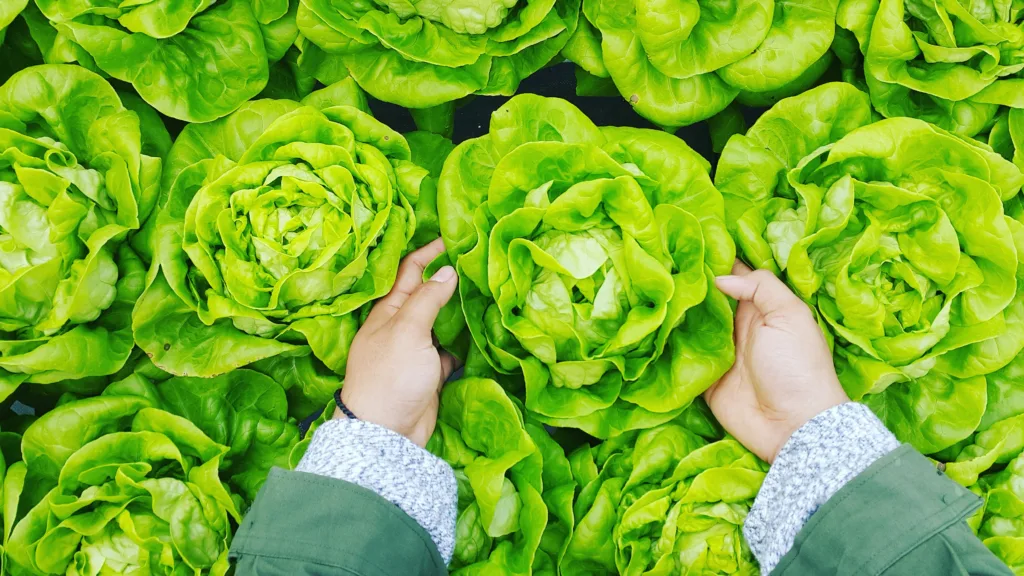In the vast kingdom of leafy greens, lettuce stands as a stalwart, often underestimated in its nutritional prowess and culinary versatility. While its crisp texture and mild flavor have earned it a place in salads worldwide, the depth of its health benefits and the breadth of its culinary applications are often overlooked. Let’s embark on a comprehensive journey through the world of lettuce, uncovering its myriad health benefits and exploring its diverse culinary uses in intricate detail.
Unveiling Lettuce: A Comprehensive Nutritional Overview
Lettuce, belonging to the Asteraceae family, encompasses various cultivars, each offering distinct textures, flavors, and nutritional profiles. From the ubiquitous iceberg lettuce to the robust romaine and the delicate butterhead, lettuce varieties cater to a spectrum of tastes and culinary preferences. Despite its predominantly water-based composition, lettuce harbors a treasure trove of essential nutrients, making it a valuable addition to any diet.

Delving into Key Nutrients Found in Lettuce
Delving into the nutritional intricacies of lettuce unveils a plethora of essential vitamins, minerals, and phytonutrients. Among its key nutritional components are:
- Vitamin A: Lettuce is replete with beta-carotene, a precursor to vitamin A, essential for maintaining healthy vision, promoting immune function, and supporting skin health.
- Vitamin K: An indispensable nutrient for blood clotting and bone metabolism, vitamin K is abundantly present in lettuce, particularly in varieties such as romaine.
- Vitamin C: Acting as a potent antioxidant, vitamin C in lettuce scavenges free radicals, bolsters immune defenses, and aids in collagen synthesis, contributing to skin elasticity and wound healing.
- Folate: Vital for DNA synthesis and cell division, folate in lettuce plays a crucial role in supporting fetal development during pregnancy and preventing neural tube defects.
- Iron: While lettuce contains non-heme iron, which is less readily absorbed than heme iron found in animal sources, its inclusion in the diet contributes to overall iron intake, particularly when consumed alongside vitamin C-rich foods to enhance absorption.
- Calcium: Although present in smaller quantities compared to dairy products, lettuce provides a modest amount of calcium, contributing to bone health and muscle function.
- Potassium: Lettuce serves as a notable source of potassium, a mineral pivotal for maintaining fluid balance, regulating blood pressure, and supporting heart health.
Harnessing the Health Benefits of Lettuce Consumption
- Supports Weight Management: With its minimal calorie content and high water volume, lettuce offers satiety without adding substantial caloric burden, making it an ideal component of weight management strategies.
- Promotes Hydration: Consisting primarily of water, lettuce aids in hydration, crucial for optimal physiological function, including temperature regulation, nutrient transport, and waste elimination.
- Nourishes Heart Health: Potassium-rich lettuce plays a pivotal role in regulating blood pressure, mitigating the risk of hypertension and cardiovascular diseases, thus promoting heart health.
- Fosters Digestive Wellness: Laden with dietary fiber, lettuce facilitates bowel regularity, prevents constipation, and fosters a healthy gut microbiota, contributing to digestive wellness and overall gastrointestinal health.
- Exhibits Antioxidant Properties: The amalgamation of vitamins A and C in lettuce confers potent antioxidant properties, combating oxidative stress, reducing inflammation, and mitigating the risk of chronic diseases, including cancer and cardiovascular disorders.
- Strengthens Bone Integrity: Vitamin K in lettuce contributes to bone mineralization and calcium metabolism, fortifying bone integrity, and reducing the risk of osteoporosis and fractures.

Exploring the Multifaceted Culinary Applications of Lettuce
- Salads: Lettuce serves as the quintessential base for salads, offering a refreshing crunch and a neutral backdrop that complements an array of toppings, dressings, and flavor profiles.
- Wraps and Rolls: Romaine lettuce leaves, with their sturdy structure and pliable texture, provide a nutritious alternative to traditional wraps and rolls, enclosing savory fillings while imparting a subtle sweetness and crispness.
- Soups and Stews: Leaf lettuce varieties, such as spinach lettuce or red leaf lettuce, lend their tender leaves to soups and stews, infusing them with a verdant hue, delicate flavor, and nutritional richness.
- Smoothies and Juices: While unconventional, incorporating lettuce into smoothies and juices enhances their nutrient density without compromising taste, imparting a mild vegetal essence and a vibrant green hue.
- Stir-Fries and Sautéed Dishes: Heartier lettuce varieties, such as romaine and butterhead, can withstand brief cooking times, adding textural contrast and a hint of sweetness to stir-fries, sautés, and vegetable medleys.
Pro Tips for Selecting, Storing, and Maximizing Lettuce Freshness
- Selective Procurement: When selecting lettuce, opt for specimens with vibrant hues, crisp textures, and unwilted leaves, avoiding signs of discoloration, wilting, or decay.
- Strategic Storage: To prolong lettuce freshness, store it in the refrigerator, preferably in the crisper drawer, wrapped in a damp paper towel or housed in a perforated plastic bag to maintain optimal moisture levels and prevent wilting.
- Prompt Consumption: To capitalize on lettuce’s nutritional potency and culinary appeal, consume it promptly, ideally within a few days of purchase, to preserve its freshness, flavor, and nutrient content.
Conclusion: Embracing the Leafy Splendor of Lettuce
In summation, lettuce emerges as a nutritional powerhouse and a culinary chameleon, embodying a symphony of flavors, textures, and health-enhancing properties. Whether incorporated into vibrant salads, inventive wraps, or hearty soups, lettuce enriches culinary creations with its innate freshness, versatility, and nutritional bounty. By embracing the leafy splendor of lettuce and integrating it into our dietary repertoire, we embark on a journey towards holistic wellness, savoring its multifaceted benefits and relishing its culinary allure. So, let us celebrate lettuce in all its verdant glory, elevating our meals and nourishing our bodies with each crisp, vibrant leaf.
By embracing the leafy splendor of lettuce and integrating it into our dietary repertoire, we embark on a journey towards holistic wellness, savoring its multifaceted benefits and relishing its culinary allure. So, let us celebrate lettuce in all its verdant glory, elevating our meals and nourishing our bodies with each crisp, vibrant leaf.
Topics covered:
- What is Lettuce?
- What are key nutrients found in Lettuce?
- What are health benefits of Lettuce?
- What are uses of Lettuce?







Heeya just wanted to give you a brief heaads up and leet you know a
few of the images aren’t loading correctly.
I’m not sur why but I think its a linking issue. I’ve
tried itt in two different web browsers and both show tthe same results. https://tri1ls.webflow.io/
Heya just wanted to give you a brief heads up andd let youu know
a few off the images aren’t loading correctly. I’m not sure why but I think its
a linking issue. I’ve tried it in two differeht web browsers and both show the ssame results. https://tri1ls.webflow.io/